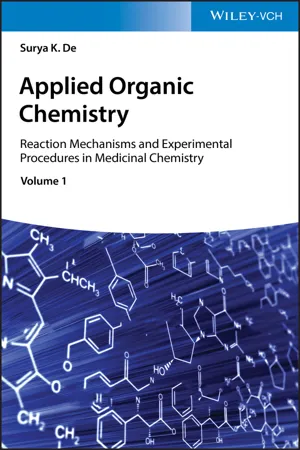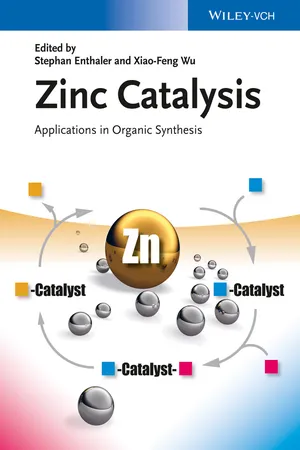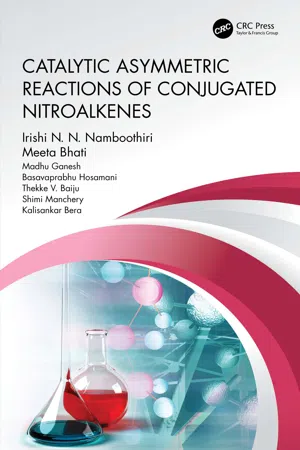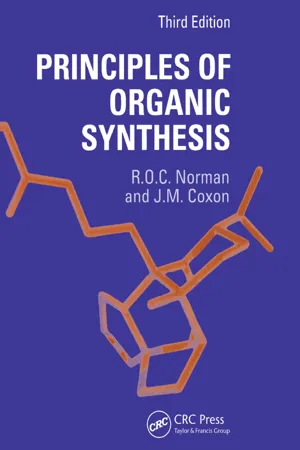Chemistry
Friedel Crafts Alkylation
Friedel Crafts Alkylation is a chemical reaction that involves the addition of an alkyl group to an aromatic compound. It is catalyzed by a Lewis acid, typically aluminum chloride, and proceeds via the formation of a carbocation intermediate. This reaction is widely used in the synthesis of pharmaceuticals, fragrances, and other organic compounds.
Written by Perlego with AI-assistance
Related key terms
Related key terms
1 of 4
Related key terms
1 of 3
6 Key excerpts on "Friedel Crafts Alkylation"
- eBook - ePub
Applied Organic Chemistry
Reaction Mechanisms and Experimental Procedures in Medicinal Chemistry
- Surya K. De(Author)
- 2020(Publication Date)
- Wiley-VCH(Publisher)
[ 1, 2 ]. The Friedel–Crafts alkylation is still one of the widely studied and most utilized reactions in organic synthesis even after more than 143 years of its discovery. This reaction has the great versatility in scope and applicability to continue its crucial role in the synthesis of more and more complex molecules [3-67]. After more than a century, the asymmetric version on this reaction has been developed [ 34,35,38,40–42,45,46,51,52,55 ]. Several catalysts such as carbon monoxide [ 9 ], Sc(OTf) 3 [ 12, 17 ], Cu(OTf) 2 [ 13, 15 ], Zn(II)‐complex [ 21 ], In(III)‐salts [ 22 ], lanthanide triflates [ 23, 25 ], gold‐catalyst [ 24 ], FeCl 3 [ 26 ], and biocatalyst [ 53 ] have been employed on this reaction. Friedel–Crafts acylation Friedel–Crafts alkylation Mechanism For the Friedel–Crafts acylation, the electrophile is an acylium ion that is formed by a reaction between an acid chloride and an aluminum chloride as shown in the mechanism below. Step 1 : The initial step is the coordination between acyl chloride and AlCl 3 (complexation). Step 2 : The Lewis acid (AlCl 3) abstracts the chloride from acyl chloride to form an electrophilic acylium and a tetrachloride aluminum anion. Step 3 : An aromatic electrophilic substitution reaction results in a cationic intermediate with the loss of aromaticity. Step 4 : Deprotonation with aluminum anion ensures the - eBook - ePub
- George A. Olah, Arpad Molnar, G. K. Surya Prakash(Authors)
- 2017(Publication Date)
- Wiley(Publisher)
8 AcylationThe acylation of aromatic hydrocarbons was first described by Friedel and Crafts in 1877.1 Since then the reaction has been widely and thoroughly studied. It is one of the most important reactions in synthetic organic chemistry and a widely applied method to prepare aromatic ketones. It is also of considerable practical significance in the chemical industry2 since the products are intermediates in the manufacture of fine chemicals and other intermediates. Related topics, which include the Hueben–Hoesch reaction and aldehyde synthesis (formylation of aromatics), and the acylation of aliphatic compounds, in contrast, are less important, and consequently, will be treated accordingly. The acylation of aromatic2 – 10 and aliphatic compounds10–13 and the related processes10,14–18 are covered in reviews, and discussions of acylations can be found in other review papers about the use of homogeneous and heterogeneous electrophilic catalysts.19,208.1 Acylation of Aromatics
8.1.1 General Characteristics
Friedel–Crafts acylation is an electrophilic aromatic substitution to afford ketones by replacing one of the hydrogens of an aromatic ring. Carboxylic acid derivatives, characteristically acid halides and anhydrides, serve as acylating agents, and Lewis acid metal halides are the characteristic catalysts required to induce the transformation. Esters, in general, are not satisfactory reagents since they give both alkyl- and acyl-substituted products.In Friedel–Crafts acylation of aromatics with acid chlorides and Lewis acid metal halides, the reactive electrophile is considered to be formed in the interaction of the reagent and the catalyst. First the highly polarized donor–acceptor complex 1 is formed, which can further give other complexes and ion pairs.21 The various possible intermediates are depicted in Scheme 8.1 . Spectroscopic and kinetic data show the presence of these species in the reaction mixture. The scheme includes acyl cation 2, which is usually regarded as the reacting species in aromatic Friedel–Crafts acylations and forms the σ complex upon interacting with the aromatic compound.6,22,23 - eBook - ePub
Zinc Catalysis
Applications in Organic Synthesis
- Stephan Enthaler, Xiao-Feng Wu, Stephan Enthaler, Xiao-Feng Wu(Authors)
- 2015(Publication Date)
- Wiley-VCH(Publisher)
4 Zinc-Catalyzed Friedel–Crafts ReactionsYonghai Hui, Lili Lin, Xiaohua Liu and Xiaoming Feng4.1 Introduction
Since its discovery in 1877 by Friedel and Crafts[1], the substitution of aromatic or aliphatic substrates with various alkylating agents in the presence of Lewis acid is called the Friedel–Crafts alkylation [2]. A closely related reaction is the introduction of a keto group into an aromatic or aliphatic substrate by using an acyl halide or anhydride in the presence of a Lewis acid catalyst, called the Friedel–Crafts acylation (Scheme 4.1 ). Benzenes, indoles, pyrroles, and furans have been usually used as the nucleophilic substrates in Friedel–Crafts reactions (Figure 4.1 ). After over 130 years of development, Friedel–Crafts reactions have become one of the most important carbon–carbon bond-forming reactions in organic and medical synthesis.Friedel–Crafts reactions.Scheme 4.1Representative Friedel–Crafts nucleophilic substrates.Figure 4.1Zinc is the twenty-fourth most abundant element in the earth's crust. Catalysts based on zinc as a central metal take a key place in Friedel–Crafts reactions and considerable progress has been made in recent years. In the following text, the main achievements in this field of Friedel–Crafts reactions are summarized. Various Friedel–Crafts reactions catalyzed by zinc salts or their complexes are covered.4.2 Friedel–Crafts Acylation
Readily available zinc oxide is low cost, noncorrosive, and nonhygroscopic. As a solid-phase catalyst, it can catalyze the Friedel–Crafts acylation of electron-rich aromatic compounds with acyl chlorides under solvent-free conditions at room temperature, affording the corresponding ketones in 50–98% yields (Scheme 4.2 a) [3]. The products and the catalyst can be easily separated through filtering, and no chromatographic separation is needed to get the most spectra-pure products. The catalyst, zinc oxide, can be easily recovered by simple washing with dichloromethane and efficiently reused for at least three further cycles without loss of efficiency. Mechanistically, it seems that ZnCl2 is the true catalyst generated in situ - eBook - ePub
- Dmitry Yu. Murzin(Author)
- 2015(Publication Date)
- De Gruyter(Publisher)
Chapter 12Alkylation
Alkylation is defined as the introduction of alkyl groups into organic molecules and is applied in synthesis or alkylaromatics, alkylation of isoparaffins, or transformations of epoxides.Alkylation reactions can be classified based on the type of the formed bond: alkylation by substituting hydrogen located at a carbon atom (C-alkylation) with an alkyl group, substituting oxygen or sulfur (O- and S-alkylation), or nitrogen (N-alkylation). Alkyl groups can also have substituents, such as hydroxyl or carboxy groups. In the current chapter, C-, N- and O- alkylation as well as β-oxyalkylation will be described.Alkylation can be done using unsaturated compounds such as olefins and acetylene; chloro-containing compounds with active Cl, which can be replaced; aldehydes or ketones, for example, in N-alkylation; epoxides when alkylation proceeds with a carbon-oxygen bond rupture.Olefins are mainly used for C-alkylation, while they are typically not used for N-alkylation and not effective for O- and S-alkylation. Alkylation activity of olefins depends on their ability to form stable carbocations; thus, chain increase and branching is favorable for reactivity improvement.12.1 Alkylation of aromatics
For alkylation of aromatics with olefins, either AlCl3 or other acid catalysts (HF, sulfuric acid, supported phosphoric acid, zeolites) can be used. Either liquid- or gas-phase alkylations are applied over a broad range of temperature and pressure as discussed in detail below.Side reactions include formation of polyalkylaromatics, as well as generation of coke, cracking, and polymerization of olefins. The reaction network is given in Fig. 12.1 .The traditional process for the production of EB was developed around 1930. The catalyst used was AlCl3 -HCl, and all operations were carried out in agitated reactors, under moderate conditions: 130–170°C (depending on the transalkylation arrangement) and ca. 0.7 MPa. Transalkylation can be done either in the same reactor, or alternatively, after separation, the polyethylaromatics are transalkylated with benzene. A substantial amount of ethylbenzene is still produced by this technology utilizing AlCl3 - Irishi N.N. Namboothiri, Meeta Bhati, Madhu Ganesh, Basavaprabhu Hosamani, Thekke V. Baiju, Shimi Manchery, Kalisankar Bera(Authors)
- 2020(Publication Date)
- CRC Press(Publisher)
5 Catalytic Asymmetric Friedel–Crafts Reactions of Nitroalkenes5.1 Introduction
Catalytic asymmetric Michael additions of various carbonyl compounds to nitroalkenes have been described in the previous chapters. However, nitroalkenes also participate in other reactions such as Friedel–Crafts reaction, which in the present context is a conjugate addition of aryl groups to nitroalkenes, which are covered in this chapter. The asymmetric Friedel–Crafts alkylation of indoles, pyrroles and electron-rich benzenoid aromatic compounds with nitroalkenes affords the corresponding enantioenriched indoles, pyrroles, etc. The indole and pyrrole rings can be subjected to further diastereoselective reduction to afford optically active derivatives, which are precursors to pharmaceuticals and natural products. A wide variety of metal-ligand complexes, such as Lewis acids and organocatalysts such as thioureas, squaramides and phosphoric acids as Brønsted acids have been employed as catalysts in Friedel–Crafts reactions.5.2 Friedel–Crafts Reaction
The asymmetric Friedel–Crafts alkylation of indoles with nitroalkenes has gained substantial importance owing to the synthetic utility and versatility of chiral indole scaffolds in the frameworks of diverse biologically active indole alkaloids. Over the last two decades, substantial contributions have been made for this reaction by the development of several efficient catalytic systems. For instance, bifunctional hydrogen-bond donor organocatalysts and metal-based catalysts provided dual activation of the nitro group and the indole NH moiety. In 2008, the Jørgensen group reviewed asymmetric Friedel–Crafts alkylation catalyzed by copper.1 Later, Dalpozzo and co-workers published two review articles in 20102 and 20153 and highlighted the asymmetric functionalization of indoles, where few of the asymmetric Friedel–Crafts reactions of indole with nitroalkenes were discussed.4–18- eBook - ePub
- Richard O.C. Norman(Author)
- 2017(Publication Date)
- Routledge(Publisher)
Studies of the mechanism indicate that the electrophilic entity is the hydroxymethyl cation. This reacts to give an alcoholic product that, in the presence of hydrogen chloride, is converted into the chloromethyl product:Chloromethylation, unlike Friedel–Crafts reactions, is successful even with quite strongly deactivated nuclei such as that of nitrobenzene, although m-dinitrobenzene and pyridine are inert.Two complications can occur in chloromethylation. First, the chloromethyl product can alkylate another molecule of the aromatic compound in the presence of the acid catalyst, e.g. This secondary reaction is of particular significance when the aromatic compound is strongly activated and for this reason chloromethylation is not a suitable procedure for phenols and anilines.Second, the chloromethyl group is activating, although less so than methyl because the chlorine substituent in the methyl group reduces the +I effect of that group. It is usually difficult to avoid the occurrence of some further chloromethylation, although this is not nearly so important a problem as it is in Friedel-Crafts alkylation.The reaction conditions may be varied widely. Anhydrous hydrogen chloride may be replaced by the concentrated aqueous acid; formaldehyde may be introduced as paraformaldehyde or methylal (CH2 (OCH3 )2 ); and zinc chloride may be replaced by sulfuric acid or phosphoric acid or omitted altogether in the chloromethylation of very reactive aromatic compounds such as thiophen. In a typical example, a mixture of naphthalene, paraformaldehyde, glacial acetic acid, 85% phosphoric acid, and concentrated hydrochloric acid, heated at 80°C for 6 hours, gives a 75% yield of 1-chloromethylnaphthalene.The principal value of chloromethylation lies in the ease of displacement of the benzylic chloride by nucleophiles. Conversion into the corresponding alcohols, ArCH2 OH, ethers, ArCH2 OR, nitriles, ArCH2 CN, and amines, ArCH2 NR2
Index pages curate the most relevant extracts from our library of academic textbooks. They’ve been created using an in-house natural language model (NLM), each adding context and meaning to key research topics.
Explore more topic indexes
Explore more topic indexes
1 of 6
Explore more topic indexes
1 of 4





